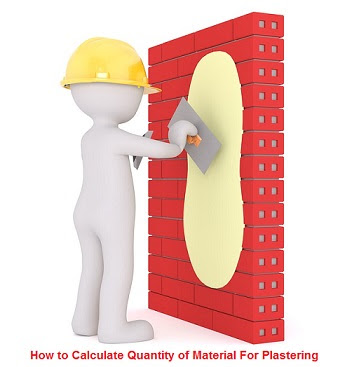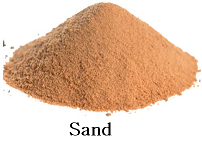Table of Contents
How to Calculate Quantity of Cement, Sand and Water For Plastering
The term plastering is used to describe the thin mortar covering that is applied on the surface of the wall and ceiling.
The plastering removes the unevenness of the surface and is sometimes used to develop decorative effects. Today in this article we will learn how to calculate quantity of material for plaster.

Important Points For Estimation
Density of Cement = 1440 kg/ m3
Density of Sand = 1450 – 1500 kg/ m3
Density of Aggregate = 1450 – 1550 kg/ m3
Quantity or Weight of Cement in 1 Bag = 50 KG
The volume of 1 Bag Cement in Cum = 0.03472 cubic meter
The volume of 1 Bag Cement in Cft = 1.226 cubic feet
Numbers of Cement Bags in 1 cum = 28.8 nos.
How many Cft in 1 Cum = 35.31 cft
Calculation of quantity of material for 12 mm thick plaster of ratio 1: 6 (1 Cement:6 Sand) in the wall for 100 Sqm
The volume of mortar = Area × Thickness
= 100 × 0.012
= 1.2
Adding 30% to fill up joints, uneven surface etc
Wet Volume of Mortar = 1.2 + 0.36
= 1.56 Cum
Increasing 25% for dry volume
Total Dry Volume = 1.56 + 0.39
= 1.95
= 2 Cum (say)

Quantity of Cement = 2/(1+6) × 1 (1 Ratio of cement)
= 0.30 Cum
In Kg = 0.30 × 1440 (Density of cement = 1440 kg/m3)
= 432 Kg
In Bags = 8.64 bags

Quantity of Sand = 2/(1+6) × 6 (6 Ratio of sand)
= 1.80 Cum
In Cubic Feet = 63.558 cft (1 Cum = 35.31 cft)
Water Required = Cement quantity in Kg × 0.5 (water cement ratio = 0.5)
= 432 × 0.5
= 216 Litres
Alternative Method
Quantity of Sand = Cement bags × Sand ratio ×1.226 (Volume of one bag cement = 1.226 cft)
= 8.64 × 6 × 1.226
= 63.55 cft
Similarly, The quantity of materials for other proportions may be calculated.
Also, Read – How to Calculate Cement, Sand and Aggregate Quantity in Concrete?
Material For 20 mm thick Plastering in the wall for 100 sqm
As the thickness of plaster is more, 20% of mortar may be taken to fill up the joints, unevenness etc.
The Quantity of wet Mortar = 100 × 0.02 + 20%
= 2 + 0.4
= 2.4 cu m
Increasing 25% for the dry volume of mortar
Dry Volume of Mortar = 2.40 + 0.60
= 3.00 cu m
The quantities of each material of mortar may be found by the usual method as discussed above.
Also, Read – Rate Analysis for Cement Plaster.
Rich Mortar
For rich mortar plastering, the quantities of material will be less as the cement will be in excess than the voids in sand and the reduction in the volume of dry mortar will be less.
Ceiling Plastering 12 mm thick for 100 sqm
For plastering in the RCC ceiling, the unevenness of the surface will be less and 20% extra mortar may be taken to get an even surface.
The quantity of wet mortar = 100 × 0.12 + 20%
= 1.2 + 1.4
= 2.6 cu m
Increasing 25% for dry volume
The dry volume of mortar = 1.44 + 0.36
= 1.80
The quantities of each material of mortar may be found by the usual method as discussed above.
For 6 mm thick plastering in RCC, the quantity of dry mortar may be taken as 1.00 cum.
Also, Read – Rate Analysis for Gypsum Plaster.
General Notes
The ratio of Cement Mortar for Wall Plastering = 1:6
The ratio of Cement Mortar for Ceiling Plastering = 1:4
The thickness of the Internal Wall Plastering = 12 to 15 mm
The thickness of the External Wall Plastering = 15 to 20 mm
The thickness of Plastering on the Concrete Face = 6 to 8 mm
Mode of Measurement For Wall Plaster As Per IS 1200 Part – 12

- For opening less than 0.5 square meters, no deduction shall be made, and no addition shall be made for reveals, sills, soffits, jambs, etc.,
- For opening greater than 0.5 square meters but less than 3 square meters, 50% or half ( one side) deduction shall be made, and no addition shall be made for reveals, sills, soffits, jambs, etc.,
- For opening bigger than 3 square meters, full deduction or 100% ( both sides) shall be made, and addition should be made for reveals, sills, soffits, jambs, etc.,
When Internal and External plaster thicknesses are different, then addition for reveals, sills, soffits, jambs, etc., shall be made as follow.
- When windows are located at the wall’s external face, then added for reveals, jambs, soffits, sills, etc., shall be made as per internal plaster thickness.
- When windows are located at the wall’s internal face, then added for reveals, jambs, soffits, sills, etc., shall be made as per external plaster thickness.
- When windows are located at the wall’s middle face, then added for reveals, jambs, soffits, sills, etc., shall be made as per internal plaster thickness for inner and external plaster thickness for the outer side. If the opening falls under 0.3 to 5 square meters then a 50% deduction shall be made from both sides.
If there is no plaster done for reveals, sills, soffits, jambs, etc., then 100% deduction shall be made for all size openings.
Plaster Material Claculator
Conclusion
So, friends, I hope I have covered all the information about how to Calculate Quantity of Cement, Sand and Water for Plastering in this article.
If you learn something, please be sure to share it with someone who might benefit from it.
If you want to add any information which has been missed in this article you can mention it in the comment section.
Also, Read
All Cement Price List Today In India 2022
Steel Price Per Kg Today In India 2022
Difference Between Cement Plaster and Gypsum plaster
How to calculate Brick, Cement and Sand in Brickwork?
How to Calculate Cutting Length of Stirrups For Beam and Column?
How to Calculate unit weight of Steel bar?
Thanks a lot
Please send me PDF documents for reference
This is wonderful, many thanks.
Thanks for your valuable feedback.
You can use plaster material calculator to solve this.
http://www.civillead.com/plaster-material-calculator/
very well written article. I am searching for these types of topics to read for a long time. You will find the same content on
Thanks for your valuable feedback. I grateful you find my content helpful.
I am so happy I found your blog and I absolutely love your information about how to calculate material for plaster and the tips you have shared are awesome. I liked and it is wonderful to know about so many things that are useful for all of us! Thanks a lot for this amazing blog!!
Thanks for your valuable feedback.